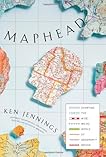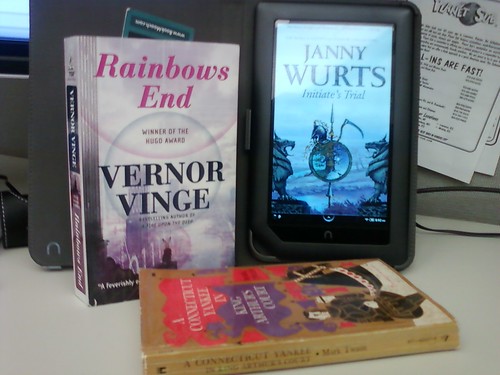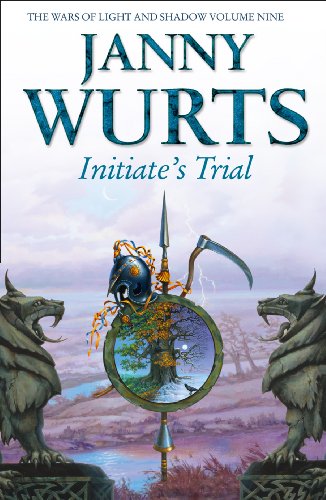 I began my Destination: Anywhere journey in mid-January, transporting myself back in time and halfway across the globe, watching the Suez Canal crisis bubble and boil and heat up the cold war and the Eisenhower Administration’s efforts to avoid World War III. As soon as I finished Eisenhower: 1956, I coordinated a day trip to the Eisenhower Presidential Library in Abilene, Kansas, taking advantage of some very unseasonably warm weather for January. I plan to return later this year to spend more quality time in the museum and help celebrate the fiftieth anniversary of the Library.
I began my Destination: Anywhere journey in mid-January, transporting myself back in time and halfway across the globe, watching the Suez Canal crisis bubble and boil and heat up the cold war and the Eisenhower Administration’s efforts to avoid World War III. As soon as I finished Eisenhower: 1956, I coordinated a day trip to the Eisenhower Presidential Library in Abilene, Kansas, taking advantage of some very unseasonably warm weather for January. I plan to return later this year to spend more quality time in the museum and help celebrate the fiftieth anniversary of the Library.
 My next stop took me even further back in time (by at least fifty or sixty years) to late 19th century Chicago. My second non-fiction book of the year, The Devil in the White City, explored the creation, construction, execution and destruction of the World Colombian Exhibition with a side of dastardly serial killing to spice up the event. I attended the Common Grounds book club discussion at the Central branch of the Kansas City Public Library in late January, since this book happened to be on the suggested reading list for the Destination: Anywhere adult winter reading program.
My next stop took me even further back in time (by at least fifty or sixty years) to late 19th century Chicago. My second non-fiction book of the year, The Devil in the White City, explored the creation, construction, execution and destruction of the World Colombian Exhibition with a side of dastardly serial killing to spice up the event. I attended the Common Grounds book club discussion at the Central branch of the Kansas City Public Library in late January, since this book happened to be on the suggested reading list for the Destination: Anywhere adult winter reading program.
 I decided I’d had enough of living in the past and caught a hyperspeed transport out to Manticoran space to catch up with Honor Harrington in Honor Among Enemies. This is the sixth installment in the series I’m reading with the Beyond Reality group at GoodReads. I welcomed the switch from hard copy to ebook, since the former requires a reading light which doesn’t automatically turn itself off when I nod off in bed. And I love being able to adjust the text size on my Nook Color and instantly look up words or names with the touch of a finger.
I decided I’d had enough of living in the past and caught a hyperspeed transport out to Manticoran space to catch up with Honor Harrington in Honor Among Enemies. This is the sixth installment in the series I’m reading with the Beyond Reality group at GoodReads. I welcomed the switch from hard copy to ebook, since the former requires a reading light which doesn’t automatically turn itself off when I nod off in bed. And I love being able to adjust the text size on my Nook Color and instantly look up words or names with the touch of a finger.
 My next destination vibrated with supernatural and musical overtones yet I couldn’t quite decide whether Archangel aspired to be a fantasy or a science fiction novel. Beyond Reality offered it up as the science fiction selection for February 2012 and I have since learned, through the online discussions there, that this novel and the sequels do belong in that genre. As soon as I finished the novel, I fired off a book recommendation to my daughter, Rachelle, mostly because the protagonist, also named Rachel, saved the day with vocal performance precision and excellence.
My next destination vibrated with supernatural and musical overtones yet I couldn’t quite decide whether Archangel aspired to be a fantasy or a science fiction novel. Beyond Reality offered it up as the science fiction selection for February 2012 and I have since learned, through the online discussions there, that this novel and the sequels do belong in that genre. As soon as I finished the novel, I fired off a book recommendation to my daughter, Rachelle, mostly because the protagonist, also named Rachel, saved the day with vocal performance precision and excellence.
 The other selection for February from Beyond Reality took me back to the Dragaeran Empire and the introduction of the fabled Vlad Taltos in Jhereg. A fun, fast fantasy jaunt full of intrigue, witchcraft, sorcery, sword fights, attempted assassinations and witty repartee. Since the edition I checked out from the Kansas City Public Library happened to be an omnibus of the first three Vlad Taltos novels, I plan to read at least the next two in the series and will eventually read all his Dragaeran books. As an added bonus, the author, Steven Brust, agreed to answer posted questions as part of our group discussion. So please stop by and join in the discussion and ask that burning question you’ve always wanted to ask.
The other selection for February from Beyond Reality took me back to the Dragaeran Empire and the introduction of the fabled Vlad Taltos in Jhereg. A fun, fast fantasy jaunt full of intrigue, witchcraft, sorcery, sword fights, attempted assassinations and witty repartee. Since the edition I checked out from the Kansas City Public Library happened to be an omnibus of the first three Vlad Taltos novels, I plan to read at least the next two in the series and will eventually read all his Dragaeran books. As an added bonus, the author, Steven Brust, agreed to answer posted questions as part of our group discussion. So please stop by and join in the discussion and ask that burning question you’ve always wanted to ask.
 Having reached five novels read by the first week of February, I filled out my Destination: Anywhere reading log (online of course) and printed my receipt. I took the short trip from the 9th floor to the lobby to hand in my receipt at the Plaza branch and receive my third adult winter reading program mug (see photo to the left for entire collection, including last winter’s Altered States mug). But have no fear! I am not stopping here! There’s still plenty to read on the Destination: Anywhere suggested reading list.
Having reached five novels read by the first week of February, I filled out my Destination: Anywhere reading log (online of course) and printed my receipt. I took the short trip from the 9th floor to the lobby to hand in my receipt at the Plaza branch and receive my third adult winter reading program mug (see photo to the left for entire collection, including last winter’s Altered States mug). But have no fear! I am not stopping here! There’s still plenty to read on the Destination: Anywhere suggested reading list.
 Tomorrow I will download my first borrowed ebook from the Kansas City Public Library. I received an email alert yesterday informing me that The Poisonwood Bible had finally become available for checkout. I may have to stop reading everything else in order to finish it before the book discussion scheduled for this Saturday at 2:00 pm to be held at Trails West branch and led by Nancy Oelke. I will read as much as I can before attending the discussion. Many of my GoodReads friends give this novel favorable ratings but no written reviews (beyond a sentence or two). I will definitely write up any of my reactions and observations and any notes I take at the discussion when I finish the book. Update (2/16/2012): I successfully downloaded the ebook from the KC Public Library’s Overdrive web site this morning and transferred it to my Nook Color. I started reading it over lunch and find myself catching my breath with the Price family upon their arrival in the Belgian Congo on the African continent at the close of the 1950s. Update (2/22/2012): I composed my review and posted it here.
Tomorrow I will download my first borrowed ebook from the Kansas City Public Library. I received an email alert yesterday informing me that The Poisonwood Bible had finally become available for checkout. I may have to stop reading everything else in order to finish it before the book discussion scheduled for this Saturday at 2:00 pm to be held at Trails West branch and led by Nancy Oelke. I will read as much as I can before attending the discussion. Many of my GoodReads friends give this novel favorable ratings but no written reviews (beyond a sentence or two). I will definitely write up any of my reactions and observations and any notes I take at the discussion when I finish the book. Update (2/16/2012): I successfully downloaded the ebook from the KC Public Library’s Overdrive web site this morning and transferred it to my Nook Color. I started reading it over lunch and find myself catching my breath with the Price family upon their arrival in the Belgian Congo on the African continent at the close of the 1950s. Update (2/22/2012): I composed my review and posted it here.
I took a side-trip away from the Destination: Anywhere suggested readings, but followed on the heels of my early Eisenhower expedition, by starting Crusade in Europe in early February. As of the writing of this blog post, the Allies had successfully advance across North Africa, capturing Tunisia, and are preparing to invade Sicily and eventually Italy. The more I learn about World War II, the more I realize how much I have yet to learn and understand. Eisenhower’s ‘big picture’ personal account of his experiences during the war keeps me riveted and turning the pages. Keeping myself to just one chapter per day can be tough, but my February reads require me to limit my non-book club reading.
 Since January fizzled without providing much if any wintery precipitation or chilly wind or freezing temperatures, I opted for an arctic expedition aboard the HMS Terror, the dark fantasy themed selection this month for the GoodReads Science Fiction and Fantasy book club. So far, for this year (and the year is still young), this is the longest (768 pages) and heaviest (I think it’s close to five pounds) hardcover book I have picked up from the library. I end up shivering as I huddle at the kitchen table reading about frostbite and disease among the crew and the extremely harsh conditions these men faced in the 1840s as they sought the fabled Northwest Passage to Asia. If early indications prove correct, subzero temperatures are not the only potentially fatal thing they need to worry about.
Since January fizzled without providing much if any wintery precipitation or chilly wind or freezing temperatures, I opted for an arctic expedition aboard the HMS Terror, the dark fantasy themed selection this month for the GoodReads Science Fiction and Fantasy book club. So far, for this year (and the year is still young), this is the longest (768 pages) and heaviest (I think it’s close to five pounds) hardcover book I have picked up from the library. I end up shivering as I huddle at the kitchen table reading about frostbite and disease among the crew and the extremely harsh conditions these men faced in the 1840s as they sought the fabled Northwest Passage to Asia. If early indications prove correct, subzero temperatures are not the only potentially fatal thing they need to worry about.
 My final stop, on the other side of the doomed Northwest Passage expedition, takes me to China. Wild Swans: Three Daughters of China relates an epic family history, following three women from successive generations as they are buffeted by changes brought by the modernization in China. I am looking forward to reading this selection, but am slightly disappointed that no book discussion was coordinated by the library as part of the Destination: Anywhere winter reading program. Perhaps I’ll start one online at the Library’s GoodReads community of readers group.
My final stop, on the other side of the doomed Northwest Passage expedition, takes me to China. Wild Swans: Three Daughters of China relates an epic family history, following three women from successive generations as they are buffeted by changes brought by the modernization in China. I am looking forward to reading this selection, but am slightly disappointed that no book discussion was coordinated by the library as part of the Destination: Anywhere winter reading program. Perhaps I’ll start one online at the Library’s GoodReads community of readers group.


















